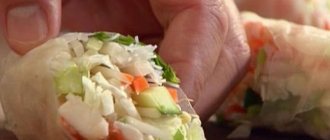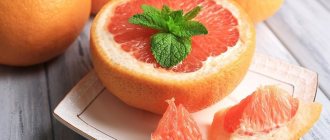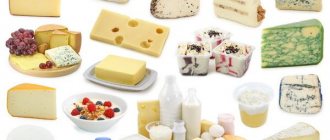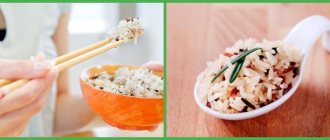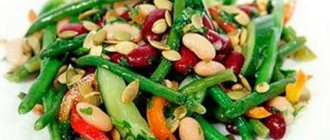Proper nutrition and a healthy lifestyle involve eating plenty of fresh fruits. These are natural sources of vitamins that strengthen the immune system and prevent many diseases. Unlike vegetables, their juicy, tender pulp satisfies even the most sophisticated tastes. The only question is how they affect the figure later. After all, they are sweet for a reason; they contain vegetable fructose. This is especially important for those who are losing weight or tend to be overweight. They need to choose only low-calorie fruits, but which ones are low-calorie fruits?
The very best, or what to eat on a diet
A sample list is as follows.
Lemon is one of the lowest in calories - about 29-31 kcal per 100g. By the way, they say that lemon water helps you lose weight well, but you can’t eat a lot of lemon itself (and it’s not suitable for all stomachs).
Right next to it are grapefruit, tangerine and orange (35-38 kcal) - citrus fruits, apparently, are among the most dietary.
Most berries have just as few calories - lingonberries, blueberries, blackberries, raspberries, cloudberries, currants, sea buckthorn, blueberries - they all have a low glycemic index and low calorie content - no more than 41 kcal per 100g.
Pears, plums, apples, cherries, cherries, peaches, and apricots are also perfect for any diet - they “weigh” on average from 42 to 56 kcal.
Below is a table of caloric content of fruits.
Lists
First of all, all those losing weight should take into account the list, which includes the lowest-calorie fruits (TOP-10):
- Momordica - creeper gourd (Africa, Australia).
- Syzygium - myrtle family (Malaysia, Australia).
- Cherry plum.
- Watermelons.
- Araz - myrtle family (Brazil).
- Capulin is a cherry-like fruit (Mexico, Guatemala).
- Lime.
- Carambola is a fruit in the shape of a five-pointed star (Sri Lanka, India, Indonesia).
- Lucuma is a sweet but low-calorie tropical fruit (Peru, Chile, Ecuador).
- Akebia is an Asian fruit that is stuffed with miso and chicken (China, Japan, Korea).
Since the leaders of this rating come from the tropics and cannot be found in a nearby store, the lowest-calorie fruit for our region is cherry plum (only 27 kcal). It is also the richest source of potassium, which is beneficial for the heart and blood vessels.
List of fruits with calorie content 34-40 kcal:
- bilimbi (cucumber tree) - oxalis family (Malaysia, Indonesia, Thailand, India);
- grapefruits;
- melons;
- cantaloupe - a type of melon (cultivated everywhere);
- lemons;
- tangerines;
- platonia - a huge fruit with aromatic and juicy pulp (Brazil, Paraguay, Colombia, Guyana);
- pomelo;
- santol - juicy, sweet, but at the same time low-calorie fruit (Vietnam, India, Cambodia, Indonesia, Southern Laos, Philippines, Malay Peninsula);
- Renet Semerenko apples are a winter variety, bright or light green, with a wine-sweet, spicy taste (widespread cultivation).
List of fruits with calorie content 41-49 kcal:
- apricots;
- oranges;
- pears of the varieties Bergamot, Bessemyanka, Duchess, Tyoma, Yuryevskaya;
- jaboticaba - tropical exotic with jelly-like juicy pulp (Brazil, Bolivia, Paraguay, Uruguay, Colombia, Philippines);
- Icaco - something between a plum and a grape (Africa, South America, Florida, Bahamas);
- kiwi;
- mineola;
- medlar is a sour fruit, but after long-term storage it becomes soft, sweet and tasty (widespread cultivation);
- nectarines;
- papaya - huge fruits with bright and tasty pulp (Mexico, USA);
- peaches;
- orange - citrus, a hybrid of tangerine and pomelo (widespread cultivation);
- sclerocaria - has juicy pulp, but a tart smell of turpentine (Africa);
- sour phyllanthus - pale yellow fruits with crispy juicy pulp (Madagascar, Vietnam, Laos, Indonesia, Malaysia, Hawaiian Islands);
- apples White filling, Granny Smith, Jonathan, McIntosh.
You can see the calorie content of each individual fruit in more detail at the end of the article in a special table.
When, how much and why
Here it is appropriate to recall the simplest rules for eating fruits.
Fruit = fat?
They are undoubtedly very useful - they contain fiber, a number of microelements and vitamins, water, by the way, in a natural structured form.
But it is worth remembering that these are simple carbohydrates. Yes, most fruits have a low glycemic index, which means that their consumption causes virtually no spikes in insulin.
However, the fructose they contain is still the same sugar, only natural. Even though it is much sweeter than sugar itself. Entering the body, it is quickly absorbed.

Part of it is converted into glucose (that is, it gives us a surge of energy), but in general it is almost completely absorbed by liver cells and converted into fatty acids. In other words, it is stored in fat!
Of course, a couple of apples a day will not give you extra pounds. Moderate consumption of fruits will only bring benefits. It remains to find out what is the recommended amount of “natural sugar” per day to consume.
How much to eat per day
Opinions differ regarding the norm. The same applies to the time of use.
My regular readers already know that, for example, in an article about portion sizes for proper nutrition, I mentioned that it is recommended to eat no more than one fruit at a time, about the size of a clenched fist (or about 200g).
But in general, it is best to limit yourself to three fistfuls of fruits (cups of berries) and vegetables combined per day. If you play sports, for example, go to the gym, then the norms can be increased. This is what some nutritionists say.
There is also an opinion: if the berries are sweet, then 200 grams, if sour, then 300 grams are possible. But fruits are no more than 1-2 pieces per day. Vegetables don't count. What is your opinion? Share in the comments!

We look at the clock
When to eat fruit?
Some fitness trainers say that only in the first half of the day, others say that it is better to leave proteins and fats for the morning, but the best absorption time for fruits comes after lunch.
Others claim that there will be no harm if you snack on fruits throughout the day. Still others are completely in favor of the fact that there will be no harm from these gifts of nature to the figure and from the evening meal.
But American scientists, whose research results were published in the American Journal of Physiology, came to the conclusion: the time of eating in this case is not important at all, since the level of insulin production is not affected by the time of day.
If you know exactly what’s best, share your experience - I’ll be glad to hear it in the comments!
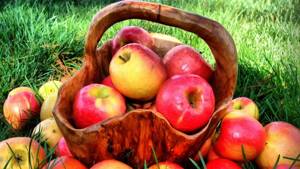
Most useful
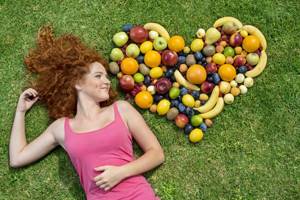
If you are looking for the healthiest low-calorie fruits for your diet, then here are the leaders among them. Naturally, we selected those that are familiar and available in most stores.
- Apples
“Whoever eats an apple a day never sees a doctor.” Contain a lot of iron. Strengthen the immune system, improve digestion, reduce the risk of heart attacks, diabetes, Alzheimer's disease, and reduce cholesterol.
- Oranges
They contain a lot of folic acid, which is beneficial for women's health, especially during pregnancy. Cleanses the blood, tones, strengthens the immune system. Beneficial for men: increase potency, improve sperm quality. Accelerate metabolism and have a fat-burning effect.
- Grapefruits
Contain a large amount of ascorbic acid and antioxidants. They strengthen the immune system, lower cholesterol, reduce the risk of atherosclerosis and ischemia, have antimicrobial and antifungal properties, and increase the acidity of gastric juice. Grapefruits are known as fat burners and are especially useful for weight loss when combined with low-fat dairy products.
- Papaya
The fruits of this plant contain a lot of papain (an enzyme that facilitates the digestion of meat) and other plant proteins. They improve digestion, alleviate intervertebral osteochondrosis and bronchial asthma, are an anthelmintic, and prevent viral infections. Useful for women: reduce pain during menstruation, normalize the cycle.
- Kiwi
Contains a lot of potassium and folic acid. They strengthen the immune system, are recommended for hypertensive patients, replenish iodine deficiency, are useful for diseases of the thyroid gland and hormonal imbalance, reduce the risk of cancer, CVD, prevent the formation of blood clots, clearing blood vessels from plaques. Kiwis are fat burners, so they are often used in weight loss diets.
- Grenades
Contain a large amount of organic acids, iron and ascorbic acid. Product #1 for anemia. They lower blood pressure, strengthen the immune system, remove heavy metals and toxins from the body, and alleviate bronchial asthma.
- Pineapples
They contain organic acids (mostly citric acid), ascorbic acid, vitamins B1, B2, B3, B6, PP, A, potassium, iron. But the most valuable thing about them is bromelain, an enzyme that is credited with the ability to burn fat. It is for this reason that pineapples are so popular among those losing weight. They improve digestion, help cope with nausea during travel, remove excess fluid from the body, speed up metabolism, and relieve swelling and thrombosis.
- Pears
Few people know that they are included in the diet of some therapeutic diets - for example, for patients with diabetes and tuberculosis. Pears contain a lot of organic acids (mostly malic), pectin and tannins, phytoncides, vitamins A, B1, C. They normalize digestion, are completely absorbed by the body, eliminate fever, have analgesic, antiseptic and diuretic properties, and are used as a fixative for diarrhea. Helps stop severe coughing.
- Persimmon
Contains a large amount of beta-carotene and bioflavonoids. Useful for CVD, hypertension, anemia, early forms of toxic goiter. In Japan it is used in the treatment of atherosclerosis and scurvy, in Thailand - helminthiasis, in Korea - dysentery, bronchitis, enterocolitis. Normalizes lipid metabolism, which promotes weight loss. Has a diuretic effect.
What to remember
- Fruits are healthy, but you still need to take them in moderation if you don’t eat exclusively fruits.
- These are simple carbohydrates that can be stored as fat if you overuse them.
- The lowest calorie ones usually have a low GI - they do not cause insulin spikes, but they charge you with energy and bring a feeling of satiety.
That's all for today. See you again, friends, and don’t forget to subscribe to updates so you don’t miss even more interesting articles about losing weight.
Other vegetables
Rounding out the top vegetables with caloric content below 40 kcal/100 grams are zucchini, broccoli, carrots, spinach, sorrel and green beans. From this list you can come up with many interesting dishes. In addition, almost every product on the list is very easy to find, especially in the summer. So, it turns out that keeping track of calories does not mean neglecting variety, you just need to approach menu planning wisely.
When it comes to healthy sweets, low-calorie fruits and berries come first in health. In addition to the fact that this dessert is tasty and easy to prepare, it is also very healthy, as it contains many vitamins. For greater benefits, the fruits should be consumed fresh, without added sugar.
Berries calorie table
It is believed that the denser the structure of the berry pulp, the more calories it contains. For example, a banana is denser than a strawberry, and its calorie content is actually higher. The sweetness of the berry is another sign of its high calorie content. The exact values can be found in the table below.
| Berry | Calorie content per 100 g (kcal) |
| Cranberry | 28 |
| Strawberry | 30 |
| Black currant | 36 |
| Raspberries | 42 |
| Blackberry | 42 |
| Gooseberry | 43 |
| Cowberry | 43 |
| Blueberry | 44 |
| Cherry | 52 |

